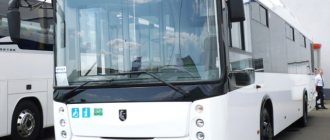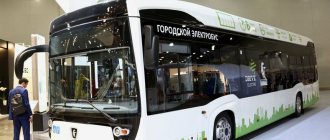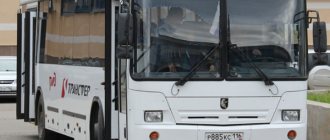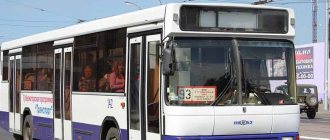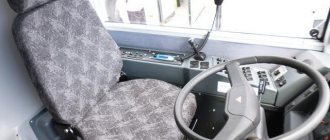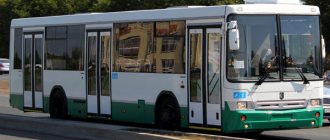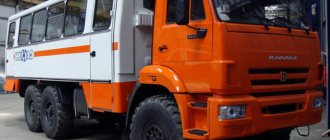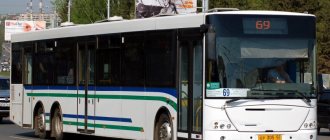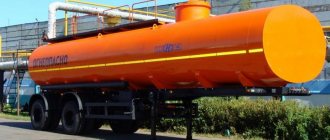| PJSC "NEFAZ" | |
| Type | Public company |
| Exchange listing | MCX: NFAZ |
| Year of foundation | 1970 |
| Location | Russia: Neftekamsk |
| Key figures | Vladimir Kurganov (CEO) |
| Industry | Automotive industry |
| Products | Buses |
| Parent company | KAMAZ |
| Website | nefaz.ru |
| Media files on Wikimedia Commons | |
PJSC NEFAZ
is an automobile manufacturing company that is part of the KAMAZ group of enterprises and is the largest Russian manufacturer of special superstructures on the KAMAZ vehicle chassis. In December 2000, the plant presented the first urban bus, NEFAZ-5299. The plant is located in the city of Neftekamsk.
Content
- 1. History
- 2 Enterprise structure
- 3 Major shareholders
- 4 Products
- 5 Achievements 5.1 2001
- 5.2 2002
- 5.3 2003
- 5.4 2004
- 5.5 2005
- 5.6 2006
- 5.7 2007
- 5.8 2008
- 5.9 2009
- 5.10 2010
- 5.11 2011
- 5.12 2012
- 5.13 2013
- 5.14 2014
- 5.15 2015
- 5.16 2022
- 7.1 Bus models 7.1.1 NEFAZ-4208
History[ | ]
On December 17, 1970, the Council of Ministers of the USSR issued a resolution “On the construction and reconstruction of factories of the Ministry of Automotive Industry to provide the Kama Automobile Plant with spare parts and components.” In those years, the construction of KAMAZ was underway, and it was decided to build satellite factories that would supply the necessary equipment.
On December 25, 1970, the State Committee of the Council of Ministers for Construction Issues issued Order No. 65 “On the creation of a plant for the production of dump trucks and winches” in the city of Neftekamsk, Bashkir Autonomous Soviet Socialist Republic. A similar order No. 4 of January 8, 1971 was issued by the Minister of the Automotive Industry of the USSR.
On July 13, 1972, construction of the plant began.
On April 15, 1977, the first ten-ton dump truck KAMAZ-5511 was assembled.
On October 11, 1977, the main conveyor was launched. Serial production of KAMAZ-5511 dump trucks has begun.
On October 31, 1977, the act of the State Commission on the acceptance into operation of the first stage of the Neftekamsk plant for the production of dump trucks was approved.
In 1981, the first stage of production of rotational buses was put into operation. Production capacity is 3,000 rotational buses per year.
On May 19, 1982, the 100,000th KAMAZ-5511 dump truck was produced.
In 1993, the plant became the Neftekamsk Automobile Plant Open Joint Stock Company.
In August 2000, the development of a high-capacity first-class city bus (according to the international classification) began.
On December 6, 2000, the first urban bus “NEFAZ-5299” was presented.
In mid-2006, the Dutch-Belgian concern VDL became interested in the plant, and from the beginning of January 2007, they, together with NEFAZ, began producing new passenger buses.
At the end of 2012, a joint venture between KAMAZ and the Brazilian Marcopolo SA "KAMAZ-Marco", located on the territory of the NEFAZ plant, began assembling small-class Bravis
. The bus is designed on a KAMAZ chassis and has 25 seats[1].
On August 28, 2012, the electric bus (electric bus) NEFAZ-52992 was certified. Autonomous electric travel is designed for more than 200 km[2].
In 2016, the Open Joint Stock Company "NEFAZ" was renamed the Public Joint Stock Company "NEFAZ".
In August 2022, the KamAZ-6282 electric bus was released, a joint development of NEFAZ and KAMAZ.
in 2020-2021 the accordion bus KAMAZ-6299-40-52
Products[ | ]
| Data in this article is as of 2012. You can help by updating the information in this article. |
Electric bus NefAZ-6282 Agricultural dump truck NefAZ-4514 on KAMAZ chassis
The company produces:
- dump trucks,
- shift buses,
- tank trucks, trailers and tank semi-trailers,
- tilt trailers and semi-trailers,
- passenger buses,
- trolleybus bodies
- agricultural machinery,
- other equipment.
NEFAZ occupies about 30% of the Russian bus market. In 2005, NEFAZ sold 1,156 buses.
Together with DAF and VDL (Netherlands), 15-meter low-floor city buses were developed, but they did not go into mass production.
In 2012, revenue from the sale of goods, products and services amounted to 10 billion 59 million rubles, the level of implementation of the 2012 business plan was 102.3 percent (111.1 percent compared to the previous year). Including shipped:
- dump trucks - 11,783 units.
- rotation vehicles - 880 units.
- passenger buses - 740 units.
- container-filling equipment - 1,351 units.
- cargo trailers - 3,837 units.
- spare parts - in the amount of 468 million rubles.
As provided for in the business plan, funds in the amount of 200 million rubles were allocated for the implementation of the investment program.
The economic effect from the implementation of the “Production System” measures amounted to 356 million rubles.
Based on the results of core activities for 2012, profit from sales amounted to 509.5 million rubles (the financial plan provided for the receipt of 352.8 million rubles). Net profit for 2012 amounted to 52.5 million rubles.
The main indicator included in the business plan for 2013 is to ensure revenue from the sale of products, goods and services in the amount of at least 10 billion 98 million rubles.
Average size of urban NEFAZ
The debut of the promising mid-size city bus NEFAZ-4299-30-52 with an overall length of 9 m, designed to carry 72 passengers, took place last fall in Moscow at the international exhibition “COMTRANS-2019” - in the material about it we already briefly talked about this very interesting machine. Now the bus has been tested and everything is heading towards the fact that it will be put into mass production at a branch of KAMAZ PJSC, the Neftekamsk Automobile Plant. Therefore, it’s time to get to know NEFAZ-4299-30-52 in more detail.
Anyone who saw an exhibition copy of this mid-size bus could not help but notice that in appearance it is completely different from the serial 12-meter bus NEFAZ-5299, which was presented at the same exhibition “COMTRANS-2019” in a modernized version. And the newcomer’s interior, as one might notice, turned out to be “tailored” in a completely different way. But it would seem that the easiest way to a medium-sized bus is to shorten a large-class bus by two or three meters. But the developers of the new product chose a different path, deciding not to unify large and medium buses, since the units of the first would be oversized for the second. And so much so that they would negate all the advantages of a 9-meter machine. This concerns the body first of all: the NEFAZ-4299-30-52 is completely original in both design and construction, as indirectly evidenced by the overall width, which is not 2.55, but exactly 2.5 m.
In terms of the main part of its components and assemblies, the newcomer is also in no way unified with the large urban NEFAZ. This is also due to the fact that for NEFAZ-4299-30-52, not a completely low-floor, but a semi-low-floor layout was adopted. In this case, such an arrangement looks the most rational: on the one hand, it allows you to meet the requirements of the “Accessible Environment” program due to stepless entry into the front and central doors, and on the other hand, it makes it possible to refuse the use of an expensive imported portal-type drive axle, due to which is usually ensured by a low floor in the rear of the cabin. Thus, only the front steered axle bears the ZF brand of NEFAZ-4299-30-52, and the rear axle, in a slightly modified form, is borrowed from the lightest KAMAZ-4308 truck in the line of Kama trucks. And the engine here is also produced by the CUMMINZ-KAMA joint venture and even of the same “B” series, but with a smaller displacement and, accordingly, less power.
We are talking about a 4-cylinder Cummins ISBe 4.5e5 185B diesel engine located in the rear overhang of NEFAZ-4299-30-52. From the decoding of the abbreviation it follows that its working volume is 4.5 liters, maximum power is 185 hp, and the environmental class is Euro-5. We add that the engine develops a maximum torque of 700 Nm, achieved at 1200 rpm. In the CUMMINZ-KAMA joint venture line, this engine is the smallest. But for a bus with a gross weight of 13 tons, which, unlike a truck, does not have to work with a trailer and whose maximum speed is limited to 80 km/h, the specified engine output characteristics are quite sufficient. The power unit includes a 6-speed Allison T270R automatic transmission. However, over time the car will also receive a budget version with a manual transmission. The fuel tank capacity is 210 l.
NEFAZ-4299-30-52 also differs from large Neftekamsk buses in other units used, which are designed for less high loads. For example, it received power steering made by Bosch AS and a front independent air suspension made by ZF, designed for a maximum of 5 tons. The brakes on all wheels are disc-type, their operation is controlled by the electronic brake force distribution system EBS from Knorr-Bremse.
Since the layout of NEFAZ-4299-30-52 is semi-low-floor, the low floor is organized only in the front part of the cabin, from the driver’s cabin to the end of the second doorway. Further, in order to accommodate a classic drive axle, the floor level is raised, which is why a stepped rise appears immediately after the central storage platform. The first door is single-leaf, 650 mm wide, the second is double-leaf, its width is twice as large - 1245 mm. In the salon opposite it there is a large storage area on which you can freely place a child or wheelchair. To bring the latter into the bus, a folding ramp is provided in the opening of the central door. In total, the cabin has 25 anti-vandal seats - plastic, with fabric seats and wide handles on the top of the backrests. The heating system is liquid, equipped with an autonomous heater. Several heaters are located in the cabin, and another front heater is located in the driver's cabin.
According to information received from the development company, today there are no plans to create modifications of this bus model with a different body length. But the designers are working on a version with a Weichai gas engine. In addition, there is the possibility of the appearance of suburban and even intercity modifications, but only after NEFAZ-4299-30-52, having completed certification tests at the end of summer 2021, goes into mass production. It should start in 2022.
Konstantin Zakurdaev
KAMAZ bus Nefaz bus middle class bus city bus NEFAZ-4299-30-52NEFAZ-4299. NEFAZ-5292Neftekamsk Avtozavod low-floor busST-KT
Tweet
Achievements[ | ]
| This section is excessively long or contains unimportant details. If you do not agree with this, please show in the text the materiality of the material presented. Otherwise, the section may be deleted. Details may be on the talk page. |
2001[ | ]
The urban bus "NEFAZ-5299" became a laureate of the republican competition "Best Products of Bashkortostan" and a diploma winner of the competition program "100 Best Products of Russia".
For the creation of the design, technology and organization of production of passenger buses, the State Prize of the Republic of Bashkortostan 2001 in the field of science and technology was awarded to the General Director of the Neftekamsk Automobile Plant R. S. Malikov, Technical Director V. M. Syutkin and the head of the experimental workshop Z. A. Garipov.
Certificate of conformity GOST R ISO 9001-2001 (ISO 9001:2000)
2002[ | ]
The NEFAZ-5299-01 commuter bus also became a laureate of the republican competition “Best Products of Bashkortostan” and a laureate of the competition “100 Best Products of Russia”.
2003[ | ]
The intercity bus "NEFAZ-5299-10" received a diploma as a laureate of the "Best Goods of Bashkortostan" competition and became a diploma winner of the "100 Best Goods of Russia" competition.
2004[ | ]
Honorary Diploma of the Ministry of Economic Development and Trade of the Russian Federation “Best Russian Exporter of 2004”.
2005[ | ]
The tourist bus "NEFAZ-52991" won the Laureate Diploma of the republican competition "Best Products of Bashkortostan" and the Program "100 Best Products of Russia".
2006[ | ]
The bus for transporting disabled people “NEFAZ-52-99-10-15” became a Laureate of the “100 Best Products of Russia” Program.
2007[ | ]
The city semi-low-floor bus "NEFAZ-VDL-52997" was recognized as a Laureate of the "100 Best Products of Russia" Program.
2008[ | ]
The tourist bus "NEFAZ-VDL-52999" was recognized as a Laureate of the "100 Best Products of Russia" Program.
2009[ | ]
The intercity bus "NEFAZ-VDL-52996" was recognized as a Laureate of the "100 Best Products of Russia" Program.
2010[ | ]
The three-axle 15-meter bus “NEFAZ-VDL-52998” was recognized as a Laureate of the “100 Best Products of Russia” Program.
2011[ | ]
The NEFAZ-5299-30-31 passenger bus with a gas engine was recognized as a laureate of the All-Russian competition “100 Best Products of Russia”
Diploma and Cup of the Government of the Republic of Belarus “For contribution to the development of the economy of the Republic of Bashkortostan” based on the results of 2003, 2004, 2005, 2006, 2007
Diploma of the winner of the fifth All-Russian competition “1000 best enterprises and organizations of Russia” “For effective activities, high achievements and stable work” in 2004 and 2005.
Diploma “Best Industrial Company of the Republic of Bashkortostan” in 2006 and 2007.
2012[ | ]
NEFAZ is the winner of the “Best Exporter of the Year” competition.
The “NEFAZ-52994” bus is the winner of the “Best Products of Bashkortostan” competition.
The NEFAZ-52994 bus was recognized as a Laureate of the competition “100 Best Products of Russia”
The KAMAZ M1842 (5490) long-haul tractor won the “Best Commercial Vehicle of the Year in Russia” competition in 2012 in the “Prospect of the Year” category.
2013[ | ]
The new NEFAZ tank is a laureate of the “100 Best Products of Bashkortostan” competition.
The 10,000th NEFAZ passenger bus was produced.
The new NEFAZ tank is among the “100 best products of Russia.”
2014[ | ]
The Neftekamsk Automobile Plant was awarded the 1st degree Diploma of the President of the Republic of Bashkortostan in the field of product quality (goods, services) for 2013.
The KAMAZ M1842 (5490) long-haul tractor won the annual competition “Best Commercial Vehicle of the Year in Russia” in the “Truck of the Year” category. The award ceremony took place in Moscow during the International Specialized Exhibition of Trucks AUTOTRANS-2014.
The first 10,000 km of mileage appeared on the odometer of the Russian large-class electric bus NEFAZ-52992, which is used in the corporate transport fleet of the Novosibirsk Chemical Concentrates Plant, the largest nuclear fuel cycle enterprise, part of the TVEL Corporation.
On November 14 in Ufa, at the republican conference dedicated to World Quality Day, the award ceremony for the winners of the 17th All-Russian competition “100 Best Products of Russia” 2014 took place.
The Neftekamsk Automobile Plant also won a diploma as a laureate of the competition. The transport semi-trailer “NEFAZ-93341-08” was presented for the competition, designed for transporting various cargoes along the general road network.
2015[ | ]
On June 3, the results of the republican competition “Best Products of Bashkortostan” were summed up. The firefighting vehicle ATs 3.0-40 (43502) produced by the Neftekamsk Automobile Plant was awarded the laureate's diploma.
The Neftekamsk Automobile Plant occupies a leading position in the national ranking of Russian enterprises in the field of foreign economic activity “Exporter of the Year/Importer of the Year” based on the results of 2013-2014. Based on the sum of four indicators of foreign economic activity, the Neftekamsk Automobile Plant is in the gold rating of “Exporter of the Year” in the product group “Ground Transport Means”. The company was awarded an official international certificate and a medal “Exporter of the Year 2015”.
2018[ | ]
From 2022 to the present day, the plant has been a manufacturer of electric buses for Mosgortrans. Another interesting fact is that the first domestic serial electric car was named after its native Neftekamsk, but the name Neftekamsk itself comes from the word “Oil”, that is, it turned out to be the first electric car named after oil.
Model of the city bus NefAZ-5299-30-32 (5299CN) in 12th scale
How we made NEFAZ
Yuri Pozdeev, photo by the author
The name of Igor Nikolaevich Shvetsov is well known among 43 scale collectors. An active, honest and sympathetic person, he was the soul of our small team. We had many ideas for new projects, but fate decreed otherwise. In an instant he was gone, and the projects remained gathering dust on the shelves.
I dedicate this article to the memory of my friend and mentor I.N. Shvetsova.
We learned from a familiar modeller that the NEFAZ museum requires a model of the city bus NefAZ-5299-30-32 (5299CN) in 12th scale to replenish the museum exhibition. We have already made small-scale and piecemeal models in our usual 43rd scale - these were both conversions and cars from scratch. And here is such a large copy. But this did not bother Igor at all. "Why not?!" - he said and rubbed his hands, as if anticipating the upcoming big and interesting work.
We met with the customer and discussed for a long time all the requirements and nuances of the order. I can’t say that the requirements from NEFAZ were impossible to fulfill, and therefore, after a short meeting, we made the final decision that it was quite possible to implement the model on such a large scale. And we have already officially confirmed our decision to make a model of the bus.
A long period of work began with drawings and photographs. Naturally, we immediately made the drawings in 12th scale. They were so large that we simply did not allow household members to pass through. When Igor and I worked, all other life in the apartment froze. We occupied everything: tables, stools, ironing board, etc., etc. Therefore, special thanks to all the residents of our small apartment for their patience and all possible help.
When making a large model, in addition to what we already knew and used, we had to use new materials and technologies that were unusual for us. And all this experience was fully useful to us in our further work on the 43rd scale.
To make a model of this size strong and at the same time lightweight, we had to experiment a lot with different materials. After testing different technologies and materials, our choice settled on cellular polycarbonate, which has low weight and good lateral strength.
We made the sides of the body of the bus model from plexiglass, tinted by a company that makes signs. The side panels were cut to size according to the drawings, and the wheel wells were not forgotten. The shape of the panels with all the curves was given thanks to specially made equipment from plywood and slats. We gave the plexiglass the desired shape with an industrial hair dryer, heating the material in places of deformation. All bends were made in approximately the same way.
Then the bus roof made of cellular polycarbonate, previously cut and curved according to a template, was glued to the sidewalls of the body. The gluing process took place in an improvised conductor, shaped like the cross section of the bus, with reinforcing pins, and all seams were completely filled with superglue.
Since during negotiations with representatives of NEFAZ it was planned to produce several models of buses, it was decided (to be able to produce in unlimited quantities) the front part of the model, as the most complex part, should be manufactured using the RubberKit method. For this purpose, a master model was made from plastic, and a mold was made from automotive sealant.
We glued the front part of the bus using well-known aircraft modeling technology, using fiberglass and epoxy resin. The back part, since it has a simpler shape, was made of sheet plastic.
The model was intended for static display in the NEFAZ museum, so the manufacture of the lower part, bridges and frame was not provided. We also made the floor and wheel arches of the bus model from cellular polycarbonate. We assembled this part, whenever possible, from closed rectangular sections, which gave the material longitudinal strength.
To make the seats, we first had to create a master model from plastic, and then a mold using a similar technology to the front part of the bus model, with the only difference being that instead of fiberglass, ordinary fabric was used here. The seats were made with a small quantity reserve, so I had to experiment with their coloring. As a result, all the seats were painted gray - the color of the plastic of real seats.
All the little things: emergency exit hatches, door opening mechanism covers, route indicators, fire extinguishers, etc. were made from different types of plastic using paper clips and nails and painted in the appropriate colors with an airbrush.
When it was time to make handrails in the cabin, since this is a city bus, the question arose: “What are they made of?” The search was long and painful. In the end, we chose yellow cocktail tubes as the material, and everything turned out just like a real bus. You will say - not strong! Everything turned out very durable, because we placed wooden kebab sticks inside the tubes. The elements simulating aluminum handrail connectors were made of black self-adhesive film, cut into strips of the appropriate width. To finish the floor and wheel arches, we used self-adhesive film, but in gray color.
The body, both outside and inside, was covered with white self-adhesive film. The front and rear parts of the bus are airbrushed with paint matched to the color of the film. To give greater strength, while working on the body, a floor with handrails is temporarily attached to it with masking tape. After pasting the film in unnecessary places (windows and doors), it was carefully cut along the contour with a knife and removed. All decorative elements and window frames on the body were imitated with multi-colored self-adhesive film.
We completely bent the driver's partition out of plexiglass and then covered it with self-adhesive film. The instrument panel was printed on film using a color laser printer. The steering wheel was soldered from tubes. The wipers and mirrors, as the most vulnerable parts, were soldered from a variety of metal tubes and sheet metal and painted black. For better safety during transportation, the mirrors were made working (folding).
And now the time has come for the final assembly of the model. The partition and the driver's seat took their places in the cabin. Passenger seats were positioned strictly according to the drawing (double seats were assembled in special jigs for more precise positioning), and elements of emergency hatches were installed both at the top of the roof and inside the body. Every little thing mattered: lampshades, emergency hammers, fire extinguishers, etc. Pre-bent windshields were glued into place in the window openings. All lighting equipment was made of plexiglass of various colors. Self-adhesive foil is glued to the inside of the lighting equipment to simulate reflectors.
The bus contains a large number of various nameplates and warning notices; all of them were drawn on a computer, and then printed on a color laser printer on self-adhesive film and, at the end of finishing, glued into place, giving the entire model a more lively and finished look.
Finally, at the request of the customer, stripes of the national colors of Bashkiria and the central element of the coat of arms of the Republic were applied to the model. We made all this from self-adhesive film on a plotter. The frame with the interior finishing elements installed on it, with the help of several self-tapping screws, in order to be able to correct problems that arose during the operation of the model in the museum, is attached to a fully prepared body.
The model was manufactured in compliance with all customer requirements. Only the wheels were not made, but this was discussed initially. Making the wheels would require real molds, but that would be too wasteful for a single model of this scale. Although for other models in 43rd scale we have repeatedly made metal molds and successfully cast both wheel rims from plastic and the tire itself with a rubber tread.
We put a lot of effort, money and effort into creating the model, but the result turned out great. We fulfilled all the customer’s requirements; the model was delivered to the museum in our own car, 60 km from our city. It’s just a pity that NEFAZ has not fulfilled the terms of the concluded agreement. This is a lesson to us and a warning to others.
NEFAZ buses[ | ]
Bus models[ | ]
NEFAZ-4208[ | ]
The first, which became the main, rotational bus NEFAZ-4208/4951 with a total weight of 9900 kg was created on the KAMAZ-43101/43114 (6x6) chassis with a KAMAZ-740 diesel engine of 220-260 hp. It is equipped with a glazed metal body with enhanced thermal insulation and one side door, designed for 29 seats plus 2 more seats in a separate driver's cabin. Its maximum speed is 85 km/h. A similar rotational bus NEFAZ-4211 is based on a 240-horsepower KAMAZ-4326 (4x4) chassis and is equipped with a 2-door body with 26 seats, lighter by 1150 kg.
NEFAZ-5299[ | ]
Main article: NEFAZ-5299
NefAZ-5299, running on methane
Large class bus. Made on the domestic KAMAZ-5297 bus chassis. Modifications: urban high-floor, low-floor and semi-low-floor; suburban; intercity; tourist. Currently, it is one of the most purchased buses in Russia.
The NEFAZ bus series 5299 is found in the form of models for computer games: the OMSI bus simulator in urban and suburban versions, in the game Grand Theft Auto IV in the same versions, and in the game Grand Theft Auto: San Andreas in all three versions - urban, suburban and intercity. Also, individual models of this bus are produced, one of which in 1:35 scale was presented at one of the conferences in Ufa.
NEFAZ-3299[ | ]
A small class bus, which in the future can be used on small commercial routes instead of PAZs and GAZelles. Designed in two versions: urban and intercity. After the production of about 40 small buses, their production was suspended.
NEFAZ-Daimler-42997[ | ]
A prototype of a middle-class city bus has been produced, but it has not yet been put into production.
VDL-NEFAZ[ | ]
See also: VDL-NefAZ-52998 and VDL-NefAZ-52997
Low-floor bus VDL-NefAZ-52998 in Ufa
Buses of this model appeared in 2007 as a result of joint work between the NEFAZ and VDL concerns. The result of the work was a series of VDL-NEFAZ buses of various models:
- VDL-NEFAZ-52995 - an experimental low-floor articulated bus of an especially large class was produced in several copies, which are being tested at the plant and in Ufa.
- VDL-NEFAZ-52996 is a high-class intercity bus. In 2009, he was recognized as a laureate of the “100 Best Products of Russia” program [ source not specified 1113 days
]. - VDL-NEFAZ-52997 is a partially low-floor city bus. In 2007, he was recognized as a laureate of the “100 Best Products of Russia” program [ source not specified 1113 days
]. - VDL-NEFAZ-52998 is a city three-axle partially low-floor bus.
- VDL-NEFAZ-52999 - high-class tourist bus
Bravis[ | ]
Marcopolo Bravis assembled at the Neftekamsk Automobile Plant
In December 2012, on the territory of the Neftekamsk Automobile Plant, a joint venture of KAMAZ PJSC and the world's largest bus manufacturer, Brazilian Marcopolo SA - KAMAZ-Marco JV - began assembling small-class buses on a chassis designed at KAMAZ PJSC Bravis
. The model complies with Euro-4 standards and has components from the world's largest companies: a Cummins engine, a gearbox, a Daimler axle and axle, and a Knorr-Bremse brake system. By 2016, it is planned to produce 3,000 buses per year and supply them to the regions of Russia and the CIS countries[3].
Drive Electro – NEFAZ 52992 Electric bus[ | ]
In 2011, the engineering company Drive Electro (formerly NIIKEU) together with the NEFAZ company created the first Russian electric bus. In 2012, the electric bus received a vehicle safety certificate and was put into operation in Novosibirsk[4]. Cruising range when fully loaded is 250 km. In 2014, the mileage of the first Russian electric bus exceeded 10,000 km. The possibility of recharging from the trolleybus contact network is also being considered.
He said: “It works!” How Rustam Minnikhanov tested the gas NEFAZ
Rustam Minnikhanov: “There is no doubt that these buses are modern, environmentally friendly and our residents of the capital will be happy!” Photo: president.tatarstan.ru
“WHEN OUR FINANCES ALLOW, WE WILL BUY ELECTRIC BUSES!”
“There is no doubt that these buses are modern, environmentally friendly and our residents of the capital will be happy!” - said the day before, opening the ceremony of handing over the new NEFAZ vehicles to carriers, President of Tatarstan Rustam Minnikhanov . The first batch of 53 restyled buses powered by gas engine fuel was displayed in a semicircle - each with a logo for the centenary of the TASSR. The drivers and conductors of motor transport enterprises themselves gathered to observe what was happening. Without taking off his branded KAMAZ cap and jacket after a working trip to Chelny, the President of the Republic, in the company of Kazan Mayor Ilsur Metshin , General Director of KAMAZ PJSC Sergei Kogogin and General Director of State Transport Leasing Company PJSC Mikhail Poluboyarinov , walked through the interior of one of the buses.
Minnikhanov sat behind the wheel, honked the horn and started the engine. "Works!" - he said, leaving NEFAZ. Two Kazan carriers purchased new equipment: 30 buses will be operated by the PATP-2 municipal unitary enterprise on route No. 45 and 23 units by the PATP-4 municipal unitary enterprise on route No. 36. These enterprises today service a total of 62% of bus routes, carrying 135 million passengers per year. The cost of one car is 12.5 million rubles. The carriers purchased the buses on lease within the framework of the federal project “System-wide measures for the development of road infrastructure” of the national project “Safe and high-quality roads.” 60% of the cost of the bus is a subsidy from the federal budget, 40% (5 million) will be paid by the carriers themselves.
The first batch of 53 restyled buses running on gas engine fuel was displayed in a semicircle - each with a logo for the centenary of the TASSR
Metshin called the renewal of public transport and the overall implementation of this program a challenge for the metropolis. “These beauties, these buses, are the dream of any motor transporter, any passenger,” the mayor noted. — We were one of the first in Russia to achieve the indicator for the quality of roads: 83 percent of Kazan has been brought to standard condition. Our buses, trolleybuses, trams are the constant attention of the President of the Republic to the problems of our city.” According to the mayor, in 2022, another 92 new NEFAZ buses will arrive in the capital of Tatarstan under the federal program.
Buses powered by compressed natural gas (methane) are the latest modernized version of serial equipment produced by KAMAZ. They are low-floor, can accommodate up to 108 people, are equipped with navigation and video surveillance systems, heating devices, ramps for wheelchairs, and a forced tilt system. Chinese Weichai engine of Euro-5 standard and a power of 183 kW, the maximum speed of the bus is 80 km/h. Dimensions: more than 12 meters in length and 2.5 in width, height - 3.4 meters. There are 28 seats. The volume of gas in the cylinders is 984 liters.
Ilsur Metshin: “These buses are the dream of any motor transporter, any passenger. Our buses, trolleybuses, trams are the constant attention of the President of the Republic to the problems of our city.”
New assembly technologies and advanced materials are used in the production of low-floor buses "NEFAZ 57.40.5299". The driver's workplace has been improved: visibility has been improved, a new ergonomic instrument panel has appeared, and for maximum comfort, an air-suspended driver's seat with adjustable headrest and backrest tilt has been installed.
The interior of the bus has been modified to meet modern requirements. The wide storage area has space for a bicycle, stroller and people with disabilities. Driver call buttons are installed on conveniently located handrails.
Buses powered by compressed natural gas (methane) are the latest modernized version of serial equipment produced by KAMAZ. They are low-floor and can accommodate up to 108 people.
According to the general director of KAMAZ, Kazan became one of the first cities to join the federal program and is receiving the first batch of equipment. “We put our souls into these products. We tried to make the design attractive and convenient for our passengers,” Kogogin said. — We will do everything to ensure that the equipment works efficiently, reliably, and is comfortable for residents of the city of Kazan and guests. Good luck, we’ll make sure that we don’t have any quality complaints.”
Sergei Kogogin: “We put our souls into these products. We will do everything to ensure that the equipment works efficiently, reliably, and is comfortable for residents of the city of Kazan and guests.”
In turn, Poluboyarinov noted that the company is a long-term partner of Tatarstan and supplies equipment to various sectors of the economy: “We actively interact and load the republic’s manufacturers. Since 2009, we have purchased equipment produced by KAMAZ for more than 6 billion rubles. He is one of our key partners, we hope for further mutually beneficial cooperation with the republic and KAMAZ.”
To the sound of fanfare, Minnikhanov presented a symbolic key to the bus to the mayor of Kazan and said that electric buses that KAMAZ makes for Moscow might also appear in the capital. “In the future, when our finances allow, we will buy electric buses. But such buses meet all international standards,” said the President of the Republic of Tatarstan.
To the sound of fanfare, Minnikhanov presented a symbolic key to the bus to the mayor of Kazan and said that electric buses that KAMAZ makes for Moscow might also appear in the capital
“There were some rough spots, but they are getting better”
For the first time, buses powered by gas engine fuel appeared on the capital’s roads in 2007, and the first large-capacity gas-powered NEFAZs appeared in Kazan in 2018, along with medium-capacity gas-engine vehicles of the Lotos brand (based on licensed MAZ-206 with a Chinese Yuchai engine) produced by RariTEK. Gas buses have updated the city's bus fleet, making it the youngest in Russia, and every 7th car now runs on gas. The carriers then purchased 104 gas buses, of which 82 were NEFAZ and 22 Lotos. Taking into account the receipt of new equipment, Kazan’s transport fleet has been updated by 52% over the past five years.
“The cars are of better quality, more convenient for passengers and so far they work well,” the head of the transport committee, Aidar Abdulkhakov, . “There were some rough spots, but they are being corrected,” says director of the municipal unitary enterprise “PATP No. 4” Airat Iskhakov about the operating experience. Despite the shortcomings, the carrier plans to buy gas buses in the future. As he told our correspondent, taking into account this purchase, his fleet will now have 60 gas buses. According to the leasing program, you need to pay for them in 6 years. “The Euro-5 standard engine is environmentally friendly and has shown itself to be very good; in general, this bus has many advantages. Compared to diesel, it is approximately 2 times more economical,” says Iskhakov and adds that the only problem is the extremely low number of refills. — There are currently four gas stations in Kazan. I think that given the increase in the overall number of gas buses in the city, it is necessary to consider increasing the number of gas stations in the future.” It is expected that the fifth, on Vasilchenko Street, will be completed by the summer of 2021. In general, one gas station is enough for 100 thousand people. It turns out that the capital of Tatarstan needs at least 10 gas stations.
Driver Nikolai Semenov says that due to a lack of stations, gas stations have hour-long queues in the late afternoon. “We refuel at Orgsintez, where it’s closer to us. And it’s a long way to go to RKB, IKEA or where Konstantinovka is. There are long queues, sometimes we wait for an hour and a half. We would like it to be built near the PATP near Levchenko,” notes Semenov. As for the bus itself, the driver is satisfied with the purchase: “I like it. One heater has been added, the interior is not ventilated. The buttons were moved a little, the headlights and front were updated.”
“The buses themselves significantly save costs, despite the fact that they are more expensive than diesel ones”
The situation with gas stations is improving, but it is not yet as ideal as we would like to see it, says Advertising and Marketing Director of the auto giant Ashot Harutyunyan . According to him, certain investments are coming from the republic, Gazprom and others,” Harutyunyan told BUSINESS Online. The buses themselves significantly save costs, despite the fact that they are more expensive than diesel ones. “We need to consider not only the bus itself, but the cost of ownership. The bus pays for itself in 7–8 years; it becomes cheaper than a diesel one, because there are savings on refueling,” says the advertising and marketing director of KAMAZ. “Just kidding, but many drivers, when they started switching their equipment to gas, quit, because you can drain gasoline, but you can’t drain gas.”
Albert Mukhametshin , director of the PATP-2 municipal unitary enterprise, spoke about the experience of operating gas buses since 2022 . “There were questions, but they were resolved together with the enterprise,” the interlocutor shared his opinion. — I can’t say that global changes have been made to the design of the new car. Of course, a bus requires investment in infrastructure and fire safety. There are many nuances that cannot be ignored during repairs. Be that as it may, we like the car. Leasing payments are acceptable, according to the economy we can. Now the main thing is to prevent a second wave of the epidemic, otherwise the economy will not work out. Now passenger traffic is recovering, the load is 75–80 percent.”
And yet, Kazan carriers had questions about the quality of gas NEFAZs. For example, in the winter of 2018–2019, problems arose with heating the interiors. Under car warranty, I replaced[/anchor] the standard aluminum heaters with copper-brass ones with greater heat transfer. In addition, PATP No. 4 installed additional heaters to maintain a comfortable temperature in the salons.
In December 2022, a brand new NEFAZ gas bus burned down in Kazan. According to investigators, the cause was electrical equipment malfunction. At KAMAZ, whose “daughter” is the Neftekamsk Automobile Plant, they believed that the outbreak was in the garage. The proceedings continue in the Arbitration Court of the Republic of Tatarstan, where the Kazan carrier Agromir LLC demanded damages of 9.7 million rubles from KAMAZ Leasing Company JSC and NEFAZ PJSC.
The purchase of capacious NEFAZ trucks by Kazan transport workers occurs a little more than six months after Chelny lost half a million of these same NEFAZ trucks in a scandal. Photo: BUSINESS Online
ALL THE DIFFERENCE IS IN THE ENGINE
The purchase of capacious NEFAZs by Kazan transport workers occurs a little more than six months after Chelny lost half a million of these same NEFAZs in a scandal. The city was forced to return 190 buses to the auto giant due to the fact that it could no longer pay lease payments. In the end, a debt of about a billion rubles remained, and the transport was returned in very poor condition. According to our data, KAMAZ has not yet found buyers for these buses.
Let us recall that these same gas buses were abandoned five years ago by the same Kazan carriers, dissatisfied with both the quality of the equipment and the price. Then, due to Western sanctions, NEFAZ was unable to purchase axles and gearboxes from Western equipment manufacturers. But the quality of the products of other Kazan suppliers was not satisfactory. In particular, they demanded that the German Voith gearboxes, but produced in Kazan, be replaced with imported ZTF ones, “because they are tired of repairing this Voith.”
The current buses supplied to Kazan carriers have different engines from those in Chelny. The Chelny ones had Mercedes-Benz engines, the Kazan ones were equipped with Chinese Weichai ones. There is an opinion that in many respects it was the illiterate operation of German engines that became the reason for the inoperability of the buses. Vladimir Vasev spoke about this two years ago to BUSINESS Online , when the Chelny municipal unitary enterprise placed an order for car repairs for a decent amount. Even then, the operators allegedly wanted to re-equip the buses with Chinese engines.
The head of the KAMAZ press service, Oleg Afanasyev, when asked whether the company was afraid of a repeat of the Chelny situation in the capital of Tatarstan, said: “It’s a strange question. Kazan, like many Russian cities, has been operating KAMAZ gas-powered buses for many years and has not experienced any serious problems.”
Meanwhile, in Chelny they are still looking for those to blame for the failure of transport reform. On social networks, Chelny residents continue to demand that the authorities return spacious transport to the lines, criticizing in every possible way the work of private carriers. Just the day before, during the opening of the Tatar Drama Theater, from the crowd of onlookers, two women shouted to Nail Magdeev, : “When will the buses appear?!” Before this, there were even pickets in the city for mothers with strollers, residents of Zamelekessya - one of the most inaccessible areas of the motor city in terms of transport.
By the way, the Tatarstan prosecutor's office responded to the complaints. The head of the department, Ildus Nafikov , instructed to check information about the improper organization of transportation and, in general, to assess the timeliness of measures taken by local authorities in the provision of transport services.
Some hopes were placed on private traders. The purchase of 20 MAZs was announced shortly before the pandemic. However, the deal fell through. General Director of Passenger Transportation LLC Nikolai Tyatyushkin told BUSINESS Online about why Chelny carriers cannot follow the example of their Kazan colleagues. “What funds should I use to buy buses? To purchase the same cars as in Kazan, you need to pay 12 million for one. The federal program provides state funding in the amount of 60 percent of the cost of the bus. You can only use gas-powered and low-floor equipment, regardless of the model. It turns out that the carrier only has to pay 4.8 million. But we will not solve the problem of urban transportation with one bus. We need 100 of these. Multiply it - it’s already 480 million. There is not a single carrier in Chelny willing to pay such a sum. This means that leasing is needed, because this program does not support lending. No matter what leasing companies I buy buses through - state-owned or some other - they make a markup, but not from 4.8 million rubles, but from the full cost - 12 million. And our 4.8 million turns into 9 million. So to whom does the state provide a service – the carrier or the leasing company through which the equipment is registered?” — Tyatyushkin gave his financial breakdown.
Answering the question about why they were able to organize transportation by large buses in Kazan, but not in Chelny, the general director of Passenger Transportation LLC recalled that in the capital of the republic, during the years of perestroika, the repair zone of transport enterprises was not destroyed, as happened in the motor city.
Current models of NEFAZ buses for 2022[ | ]
| Large class buses | |||||||
| Model | Type | Environmental standards | Overall dimensions L*W*H, mm | passenger capacity /seats | Engine | Gearbox type | Gearbox model |
| NEFAZ passenger buses powered by compressed natural gas | |||||||
| City buses | |||||||
| 5299-40-57 (Restyling) | Low-floor | Euro 5 | 12400*2550*3240 | 96 / 29+1(Inv) | Weichai | Automatic transmission | ZF |
| 5299-30-57 | Semi-low floor | Euro 5 | 12250*2550*3450 | 95 / 28+1(INV) | Weichai | Automatic transmission | ZF |
| Suburban buses | |||||||
| 5299-11-56 | Middle-field | Euro 5 | 11885*2500*3495 | 80 / 44 | KAMAZ | Manual transmission | ZF |
| NEFAZ passenger buses powered by liquefied natural gas | |||||||
| 5299-40-57 (Restyling) | Low-floor | Euro 5 | 12400*2550*3010…3100 | 101 / 28+1(Inv) | Weichai | Automatic transmission | ZF |
| NEFAZ passenger buses running on diesel fuel | |||||||
| City buses | |||||||
| 5299-40-52 (Restyling) | Low-floor | Euro 5 | 12400*2550*2800…3090 | 111 / 29+1(Inv) | Cummins | Automatic transmission | ZF |
| 5299-30-52 (Restyling) | Semi-low floor | Euro 5 | 12250*2550*3100…3300 | 100 / 29+1(Inv) | Cummins | Automatic transmission | Voith/ZF |
| Suburban buses | |||||||
| 5299-11-52 | Middle-field | Euro 5 | 11885*2500*3144…3250 | 80 / 44 | Cummins | Manual transmission / automatic transmission | ZF |
| Intercity buses | |||||||
| 5299-17-52 | Middle-field | Euro 5 | 11885*2500*3174 | 73/ 44 | Cummins | Manual transmission / automatic transmission | ZF |
| Buses for transporting children | |||||||
| 5299-11-52 | Middle-field | Euro 5 | 11885*2500*3100…3280 | 36 / 34 children + 2 adults 42 / 40 children + 2 adults | Cummins | Manual transmission / automatic transmission | ZF |
| Platform bus | |||||||
| 5299-40-52 | Low-floor | Euro 5 | 12155*2500*3075 | 110 / 12 | Cummins | Automatic transmission | ZF |
| Electric transport | |||||||
| Model | Class | Overall dimensions L*W*H, MM | passenger capacity /seats | Electric motor | |||
| Electric bus | |||||||
| 6282 | Big | 12400*2550*3260 | 85/ 33+1(Inv) | Asynchronous | |||
| Trolleybus | |||||||
| 62825 | Big | 12400*2550*3350 (in the folded state of the pantograph) | 85 / 33+1(Ina) | Asynchronous | |||
Gallery[ | ]
- NEFAZ in Belgorod
- NEFAZ on the streets of Ekaterinburg
- Shuttle bus NEFAZ in Kazan
- NEFAZ-5299 with gas fuel engine
- City bus NEFAZ-5299 at the Innoprom-2013 exhibition
- Salon NEFAZ-52994
- Crew bus NEFAZ-4208/4951
- Trolleybus NEFAZ-BTZ-52765, created on the basis of the NEFAZ-5299T body
- Intercity NEFAZ-5299-37-33, running on methane
- NEFAZ-52994
Sale of Nefaz buses at the best price in the showroom
Our company bears the title of a registered representative of the NEFAZ automobile brand on the territory of the Russian Federation; from us you can purchase automobile models exclusively of original production and assembly. The price of a Nefaz bus directly depends on the chosen model and the functional requirements, but it is always competitive and affordable for businesses of any size. To place an order and obtain information on the car models you are interested in, please contact the managers of the customer department, who will quickly help you decide on the most suitable car option.
Notes[ | ]
- A joint venture between KAMAZ and the Brazilian Marcopolo began production of Bravis buses in Bashkiria // ria.ru, 12/20/2012
- The NEFAZ electric bus is certified (unspecified)
(inaccessible link). Access date: September 19, 2012. Archived October 16, 2012. - A joint venture between KAMAZ and the Brazilian Marcopolo began production of Bravis buses in Bashkiria. RIA News. 12/20/2012
- The first electric bus has been certified in Russia (Russian). Behind the wheel (October 16, 2012). Access date: November 6, 2016.
- Factory panorama of non-phases. PAO Nefaz (OJSC Neftekamsk Automobile Plant)
